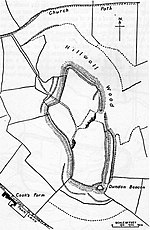Somerton Viaduct
Bridges in SomersetEngland rail transport stubsRail transport in SomersetSomerset building and structure stubsSomerton, Somerset ... and 1 more
Use British English from December 2016

The Somerton Viaduct is a historic railway viaduct in the town of Somerton in Somerset, England. It is situated on the Langport and Castle Cary Railway, known as the Castle Cary Cut-off, on the Reading to Taunton Line. It carries the railway over the River Cary.The viaduct was opened in 1906. The construction was overseen by Great Western Railway engineer P.A. Anthony.
Excerpt from the Wikipedia article Somerton Viaduct (License: CC BY-SA 3.0, Authors, Images).Somerton Viaduct
Lynch Lane,
Geographical coordinates (GPS) Address Nearby Places Show on map
Geographical coordinates (GPS)
| Latitude | Longitude |
|---|---|
| N 51.0591 ° | E -2.7263 ° |
Address
Lynch Lane
Lynch Lane
TA11 7PA , Somerton
England, United Kingdom
Open on Google Maps








